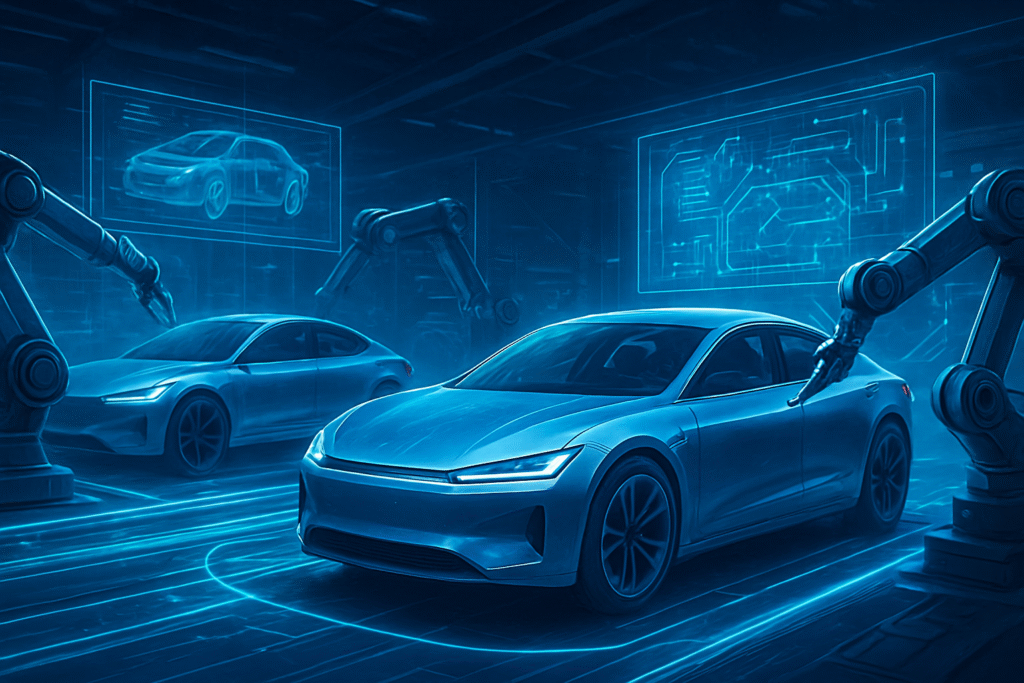
In a significant strategic pivot, Ford Motor Company (NYSE: F) is aggressively re-engineering its electric vehicle (EV) development and manufacturing processes, directly addressing the efficiency and innovation benchmarks set by industry leader Tesla (NASDAQ: TSLA). This comprehensive overhaul, spurred by an candid internal assessment of competitor vehicles, signals a new era of intense competition in the rapidly evolving EV market. Ford's CEO, Jim Farley, has openly admitted to a "shocking" and "humbling" realization of the disparities in production efficiency and design simplicity, particularly after a deep dive into the Tesla Model 3. This introspection has ignited a sweeping transformation within the Dearborn giant, aiming to streamline operations, reduce costs, and accelerate the rollout of a new generation of affordable and technologically advanced electric vehicles, with many key developments anticipated or already underway around November 2025.
The move is more than just a reaction; it represents a fundamental shift in Ford's approach to EV architecture and production. By dissecting the engineering of its rivals, Ford is not just playing catch-up but is actively laying the groundwork for a scalable and cost-effective EV future. This strategy is critical for Ford as it navigates the transition from traditional internal combustion engine (ICE) vehicles to a fully electric lineup, aiming to secure a significant slice of the burgeoning global EV market against established players and agile newcomers alike. The implications for the broader automotive industry, especially in terms of manufacturing innovation and software integration, are profound, setting the stage for a fiercely contested future.
Engineering a Revolution: Ford's Technical Response to Tesla's Efficiency
Ford's engineering response is multifaceted, focusing on fundamental design and manufacturing improvements. A pivotal discovery, for instance, revealed that the Mustang Mach-E contained 1.6 kilometers more electrical wiring than the Tesla Model 3, contributing to increased weight and higher battery costs—an additional $200 per vehicle. This insight underscored the urgent need for simpler, more integrated designs. To spearhead this transformation, Ford established its Model E division in 2022, a dedicated unit focused on fostering EV innovation and directly competing with tech-driven automakers.
Central to Ford's revised strategy is a monumental investment of approximately $5 billion into a new "Universal EV Platform" and "Universal EV Production System." This platform is engineered to serve as a scalable foundation for a new generation of affordable electric vehicles, emphasizing rapid development cycles and extensive over-the-air (OTA) software updates, a feature popularized by Tesla. The associated production system aims to revolutionize manufacturing through modular subassemblies, digital twins, and automated quality assurance. Ford anticipates these changes will reduce parts by 20%, fasteners by 25%, workstations by 40%, and assembly time by 15%, marking a concerted effort to achieve a "Model T moment" for EV affordability and efficiency. A key engineering improvement on this new platform is a significantly shorter and lighter wiring harness, projected to be over 1.3 kilometers shorter and 10 kilograms lighter than in current-generation Ford EVs.
In battery technology, Ford is making substantial moves, particularly with Lithium Iron Phosphate (LFP) batteries for its mass-market EVs. LFP batteries offer lower costs, increased durability, and enable space and weight savings. Production of LFP batteries is slated to begin at the BlueOval Battery Park Michigan in 2026, positioning Ford to be among the first automakers to manufacture prismatic LFP batteries in the U.S. Furthermore, Ford has announced breakthroughs in LFP technology, claiming the potential for no degradation, longer life, lower cost, and safer chemistry. The company also continues its investment in Solid Power, accelerating the development of solid-state battery technology, recognizing its future importance for extended range and reduced costs. While Ford recently shifted its software-defined vehicle (SDV) program from a centralized, multi-billion-dollar effort (FNV4) in May 2025, it is evolving its existing architecture (FNV3.X) to modernize software across a broader range of vehicles, including EVs, F-150s, Mustangs, and Broncos, to deliver advanced features and OTA updates. Ford's BlueCruise hands-free driving system is also expanding, gaining regulatory approval in 16 European markets and slated for wider availability in models like the Puma, Puma Gen-E, Kuga, and Ranger PHEV starting in spring 2026.
Competitive Implications: Shifting Sands for Auto Giants and Startups
Ford's aggressive re-engineering and strategic focus on affordability and manufacturing efficiency carry significant competitive implications for the entire automotive industry. Ford (NYSE: F) stands to benefit immensely if its "Universal EV Platform" and "Universal EV Production System" prove successful, allowing it to produce competitive EVs at lower costs and higher volumes. This could dramatically improve the profitability of its Model E division, which has seen initial financial losses but remains crucial for Ford's long-term EV ambitions. The emphasis on LFP batteries and streamlined manufacturing could give Ford a substantial advantage in the crucial mass-market segment, potentially undercutting rivals who rely on more expensive battery chemistries or complex production processes.
For Tesla (NASDAQ: TSLA), Ford's moves represent a direct challenge to its long-held advantages in manufacturing efficiency and software integration. While Tesla continues to innovate, Ford's focused effort to replicate and improve upon these efficiencies could erode Tesla's lead, particularly in the truck and SUV segments where Ford has a strong legacy. The push for a $30,000 mid-size electric pickup, for example, directly targets a segment where Tesla's Cybertruck, despite its unique design, occupies a different price point and market niche. This could force Tesla to accelerate its own efforts in cost reduction and introduce more affordable models to maintain its market share.
Beyond the two giants, other traditional automakers and EV startups will also feel the ripple effects. Companies that have not invested as heavily in re-thinking their EV architectures and manufacturing might find themselves at a disadvantage, struggling to compete on price and features. Ford Pro, Ford's commercial vehicle division, is already seeing strong performance with its emphasis on software, telematics, and aftermarket services, indicating how integrated software solutions can create strategic advantages and new revenue streams, a lesson for all players in the commercial EV space. The market positioning for all companies will increasingly depend not just on innovative designs, but on the underlying efficiency of their production and the sophistication of their software ecosystems.
Wider Significance: The Broader AI and Automotive Landscape
Ford's strategic pivot fits squarely within the broader trends of the AI and automotive landscapes, highlighting the increasing convergence of software, manufacturing efficiency, and sustainable energy. The "shocking" discovery of wiring complexity in the Mustang Mach-E compared to the Tesla Model 3 underscores a critical lesson for the entire industry: the future of automotive manufacturing is as much about elegant, software-defined engineering and supply chain optimization as it is about traditional mechanical design. This shift is driving a profound re-evaluation of vehicle architecture, pushing towards simpler designs that are easier and cheaper to produce, and more amenable to continuous software updates.
The emphasis on a "Universal EV Platform" and "Universal EV Production System" with modular subassemblies and digital twins is a clear embrace of Industry 4.0 principles, heavily leveraging AI and automation. Digital twins, for instance, allow for virtual testing and optimization of production lines, reducing physical prototypes and speeding up development cycles. Automated quality assurance, often powered by AI vision systems, ensures higher consistency and fewer defects. This level of integration and data-driven decision-making is becoming the new standard, moving beyond incremental improvements to fundamental re-imagining of how vehicles are designed, built, and maintained.
This development also reflects a broader societal push for more affordable and accessible electric vehicles. By targeting a $30,000 price point for its upcoming mid-size electric pickup, Ford is directly addressing one of the biggest barriers to mass EV adoption: cost. This mirrors historical automotive milestones, such as the original Model T, which democratized personal transportation. The shift to LFP batteries is another critical component of this affordability drive, offering a more cost-effective and durable solution for mass-market EVs. While the immediate focus is on engineering and manufacturing, the underlying AI-driven efficiencies in design and production will be key to unlocking this affordability, making EVs a viable option for a much wider demographic and accelerating the global transition to sustainable transportation. Potential concerns, however, include the massive capital expenditure required for such a transformation and the ability of traditional automakers to fully embrace a software-first mindset against agile tech companies.
Future Developments: The Road Ahead for Ford's EV Ambitions
Looking ahead, Ford's strategic re-engineering promises a series of significant developments that will reshape its presence in the EV market. The most anticipated is the launch of the first vehicle built on the new Universal EV Platform: an affordable mid-size electric pickup truck, targeting a starting price of around $30,000, with its debut expected in 2027. This vehicle is designed to offer performance comparable to a Mustang EcoBoost, coupled with more passenger space than a Toyota RAV4, signaling Ford's intent to capture a broad segment of the market. This platform will also underpin an all-new electric commercial van for Ford Pro customers, set to begin production in 2026 at Ford's Ohio Assembly Plant.
Further down the line, the BlueOval City complex in Tennessee is progressing towards an anticipated production start around 2026, envisioned as Ford's first Industry 4.0 plant. This advanced manufacturing facility will leverage cutting-edge automation and connectivity to produce the next generation of electric vehicles, including the delayed Project T3 electric truck, now slated for 2028 (or potentially 2026 for customer deliveries of a new truck). Additionally, Ford plans all-electric versions of its Explorer and Lincoln Aviator SUVs, with the Explorer EV expected in 2025. The Puma Gen-E is expected in spring 2026, featuring the expanded BlueCruise system, and an entry-level variant of the Capri is anticipated in early 2025 with a 52 kWh battery, offering approximately 230 miles of range.
Challenges that need to be addressed include the immense capital investment required for these new platforms and facilities, the successful scaling of LFP battery production, and the continuous evolution of Ford's software capabilities to truly deliver on the promise of software-defined vehicles. Experts predict that Ford's success hinges on its ability to execute these ambitious plans efficiently, delivering on its cost and production targets while simultaneously innovating in battery technology and advanced driver-assistance systems. The coming years will be a crucial test of Ford's ability to transform into a leading EV player, competing head-to-head with the likes of Tesla and other global EV manufacturers.
Comprehensive Wrap-Up: A Defining Moment for Ford and the EV Industry
Ford's aggressive re-engineering of its electric vehicle strategy marks a defining moment, not only for the venerable automaker but for the broader EV industry. The key takeaway is a profound acknowledgment from a legacy manufacturer that the future of automotive lies in holistic efficiency—from the simplicity of the wiring harness to the sophistication of the manufacturing process and the intelligence of the software. By openly learning from competitors like Tesla, Ford has demonstrated a willingness to dismantle and rebuild its approach from the ground up, prioritizing cost reduction, scalability, and advanced technology.
This development's significance in AI history, while indirectly, is rooted in the pervasive application of AI and automation within Ford's new "Universal EV Production System." The use of digital twins, automated quality assurance, and data-driven optimization exemplifies how AI is moving beyond niche applications to fundamentally reshape industrial processes. Ford's commitment to LFP batteries and its push for an affordable mid-size electric pickup underscore a critical market shift towards democratizing EV access, a move that will accelerate global electrification and reduce reliance on fossil fuels.
The long-term impact of Ford's strategy could be a more competitive and diverse EV market, where innovation is driven not just by technological breakthroughs but also by manufacturing ingenuity and cost-effectiveness. This could force all players to re-evaluate their production methods and supply chains, leading to a more efficient and sustainable automotive ecosystem. In the coming weeks and months, industry observers will be closely watching Ford's progress on its BlueOval City complex, the development of its Universal EV Platform, and any further announcements regarding its upcoming affordable EV models. The success of these initiatives will determine Ford's trajectory in the electric age and significantly influence the pace and direction of the global EV transition.
This content is intended for informational purposes only and represents analysis of current AI developments.
TokenRing AI delivers enterprise-grade solutions for multi-agent AI workflow orchestration, AI-powered development tools, and seamless remote collaboration platforms.
For more information, visit https://www.tokenring.ai/.


















